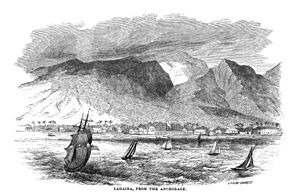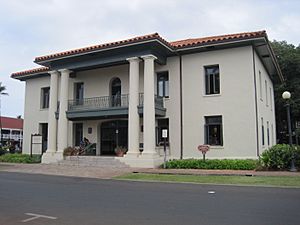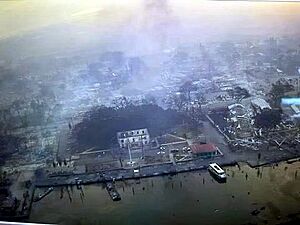Lahaina Banyan Court Park facts for kids
Quick facts for kids Lahaina Banyan Court Park |
|
|---|---|

Lahaina Banyan Court Park facing east from the corner of Hotel and Wharf Street, in 2007
|
|
| Lua error in Module:Location_map at line 420: attempt to index field 'wikibase' (a nil value). | |
| Type | Natural Area |
| Location | Lahaina, Maui |
| Area | 1.94 acres (0.79 ha) |
| Created | 1873 |
| Operated by | County of Maui |
| Open | All year |
| Parking | Limited public parking |
Lahaina Banyan Court Park is a special public park in Lahaina, Hawaii. It's also known as Lahaina Courthouse Square or simply Banyan Tree Park. This park is home to several important historical sites. It's a key part of the Lahaina Historic District.
The park sits where the Old Lahaina Fort once stood, built in 1831. This fort protected the town from rowdy sailors when Lahaina was a busy port for whaling ships. After the fort was taken down in 1854, a courthouse was built there. A small part of the old fort was rebuilt in 1964.
In 1873, Sheriff William Owen Smith planted a special Indian banyan tree in the park. He did this to celebrate 50 years since the first American Protestant mission came to Lahaina. This banyan tree grew to be the largest banyan tree in Hawaii. Its many trunks and roots now cover a huge area, about two-thirds of an acre!
Sadly, the park, including the courthouse and the banyan tree, was caught in the 2023 Hawaii wildfires in August 2023. The historic town of Lahaina burned. The banyan tree was damaged, and the Old Lahaina Courthouse was destroyed. People are now working to understand the full extent of the damage and plan for recovery.
Contents
Where is Lahaina Banyan Court Park?
Lahaina Banyan Court Park is located in the port town of Lahaina on the west side of Maui, a Hawaiian island. The park covers about 1.94 acres. It's right across from the Lahaina small boat harbor.
The park is surrounded by streets: Hotel Street to the north, Canal Street to the south, Wharf Street to the west, and Front Street to the east. Nearby historical spots include the Pioneer Inn and the Keawaiki lighthouse.
Why Was the Fort Built?
In the early 1800s, many whaling ships came to Hawaiʻi. They hunted sperm whales in the Pacific Ocean. Lahaina became a very popular place for these ships to anchor. Sailors would spend months at sea, and when they arrived in Lahaina, they often caused trouble.
Local leaders and missionaries tried to set up rules to keep order in the town. These rules sometimes made the sailors angry. There were several times when riots broke out. For example, in 1827, a whaling ship even fired cannon shots near a missionary's home!
Because of these problems, the leaders decided they needed a way to protect the town. This led to the building of the Lahaina Fort.
The Old Lahaina Fort
Queen Kaʻahumanu helped start the building of a new fort in Lahaina in 1832. This fort was meant to protect the town from the whaling sailors. Hoapili, the Royal Governor of Maui, finished building the fort in just one month.
The fort was made from large coral blocks. Its walls were about 15 to 20 feet high. It had 47 cannons! Inside, the fort stored gunpowder, guns, and swords. It was also used as a prison. Sailors who stayed in Lahaina had to return to their ships by sunset. If they didn't, they would be put in the fort's prison.
In 1841, an American naval officer named Charles Wilkes visited the fort. He noted that it was mainly used to hold "unruly subjects and sailors."
As the whaling industry slowed down, the fort became less important for defense. It was mostly used as a prison. The cannons started to rust. In 1854, the Lahaina Fort was taken down. Its coral blocks were reused to build a new prison called Hale Paʻahao. In 1964, a small part of the old fort wall was rebuilt in the park.
The Lahaina Courthouse
After the fort was demolished, a new courthouse was built on the same spot in 1859. It used stones from another damaged building. This new courthouse held many important offices. It had customs, postal services, and a tax collector's office. It also had a courtroom and a jury room.
When the Hawaiian Kingdom was overthrown, the Hawaiian flag at the courthouse was lowered in 1898. The flag of the United States was raised instead. The Hawaiian flag was later put on display inside the courthouse.
The courthouse was repaired and updated in 1925. It continued to serve as a post office and tax office. The courtroom was upstairs, and the Lahaina jail was in the basement. In 1965, it was recognized as an important historical building.
In the 1970s, it became known as the Old Courthouse. This was because the court moved to a new building. The Old Courthouse then became home to the Lahaina Heritage Museum. It also had art galleries, a visitor center, and meeting rooms. The museum reopened in 2004 with cool exhibits, videos, and historical items.
Sadly, the courthouse was destroyed by the 2023 Hawaii wildfires in August 2023. Only its charred outer walls, made of coral, were left standing.
The Famous Banyan Tree
On April 24, 1873, a small banyan tree seedling was planted in the courthouse square. Sheriff William Owen Smith planted it to celebrate a special anniversary. He received the seedling as a gift from missionaries in India. The banyan tree is native to India and is one of 60 types of fig trees found in Hawaii.
When it was planted, the seedling was about 8 feet tall. By 2005, it had grown to be 49.2 feet high. It had 16 main trunks and covered an area of about 0.66 acres! It is now the largest banyan tree in Hawaii. It's also one of the biggest banyan trees in the entire United States.
The tree faces some challenges. Too many people walking and cars driving around it can compact the soil. Droughts and problems with its watering system have also affected its health. New rules were put in place in 2000 to help protect the tree.
Every evening, many Common myna birds gather in the tree's branches. They make a lot of noise as the sun goes down!
Park Management and Events
The Maui Parks and Recreation department manages Lahaina Banyan Court Park. The Lahaina Restoration Foundation, a nonprofit group, helps maintain it. There is some public parking available on nearby streets.
The Lahaina Town Action Committee organizes all the events at Banyan Tree Park. These include "2nd Friday" events, craft fairs, and other festivals throughout the year.





